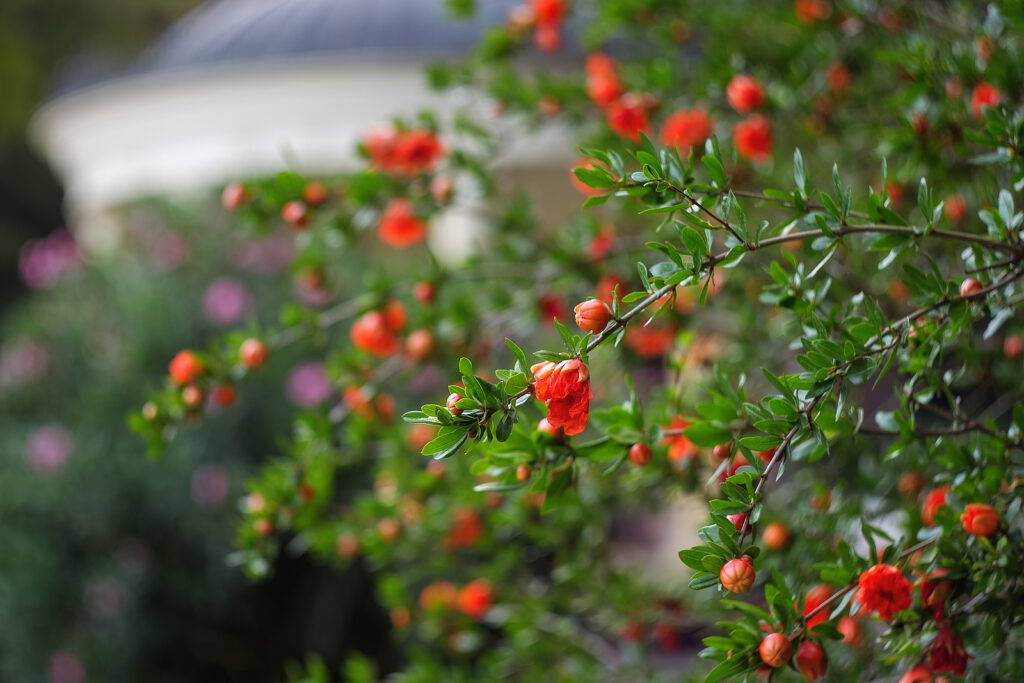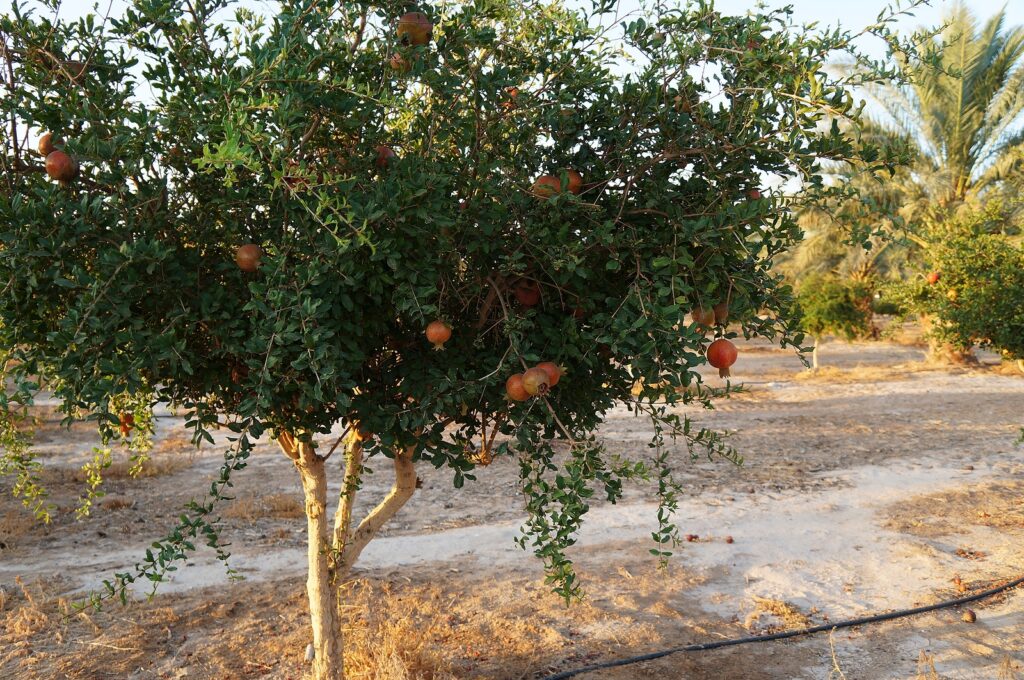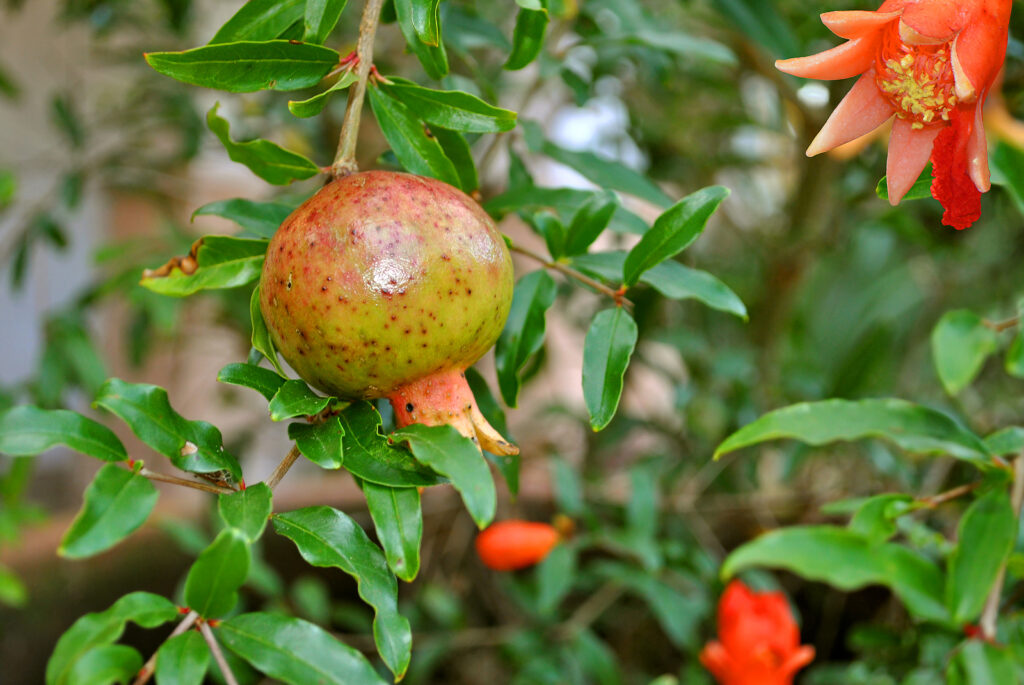Punica — commonly called Pomegranate–is grown for its showy red ruffled summer flowers and large, spherical, edible fruit. Punica can be grown in a cool greenhouse or against a sunny wall. It can be grown as a freestanding shrub or small tree or grouped in a shrub border or hedge.
Punica’s narrow leaves open bronzy then turn glossy bright green to golden green. In autumn leaves turn a brilliant yellow color except in mild winter climates where the leave can persist.
All varieties of Punica tolerate heat and a wide range of soil, including alkaline that would kill most plants.
Punica is a genus of two species. One species is native to Yemen; the other occurs from Southeastern Europe and Southwest Asia to the Himalayas.

Get to know Punica
- Plant type: Deciduous shrub or small tree
- Growing zones and range: Zones 8 to 10, but bear heavy crops of fruit only in hot dry areas
- Hardiness: Hardy to Zone 8
- Height and width: Sizes vary, from about 3 feet (.9m) tall to plants that may become 10 feet (3.1m) in height
- Growth rate: Moderate
- Form and habit: Columnar to round
- Foliage: Slender green leaves, 1.5-3 inches (3.8-7.6cm) long, that are reddish when they unfold in the spring as bronzy, then turn glossy bright green to golden green and then yellow in late fall
- Flowers: Handsome red or, occasionally, creamy yellow or striped cream-and-red flowers with ruffled petals surrounding a central clump of stamens; there are single-flowered varieties, with one row of petals, as well as double-flowered ones, with numerous overlapping petals; blossoms range from 1.5-4 inches (3.8-10.2cm) across and made of thick, fleshy petals
- Fruits: The double-flowered species do not bear fruit; most single-flowering types bear 2.5 inch (6.4cm) brownish red fruit in fall
- Bloom time: Single-flowering types bloom in early spring; double-flowering types bloom for several months in summer
- Uses: Tall hedges or stand alone; smaller ones are useful for low hedges and plantings near a house; also good in containers for patio or indoor plants
- Common name: Pomegranate
- Botanical name: Punica
- Family name: Punicaceae
- Origin: Southwest Asia, southeast Europe, and the Himalayas
Where to plant Punica
- Plant Punica in full sun.
- Punica grow in almost any soil, including slightly alkaline ones.
- In coldest part of the range, plant Punica against south or west wall.
- Where hardiness is borderline, grow Punica against a warm wall.
When to plant Punica
- Single-flowered Punica can be grown easily from seeds plants in spring to flower in four or five years.

Planting and spacing Punica
- When planting Punica for hedges, set dwarf varieties 1.5-2 feet apart (.5-.6m); tall-growing varieties 4-6 feet (1.2-1.8m) apart.
How to water and feed Punica
- Give Punica regular water for fruit production.
- Feed Punica with an all-purpose organic fertilizer in spring.
How to care for Punica
- Prune Punica only to shape young plants or to retrain the tall growth of older ones. Such pruning should be done in early spring before new growth starts so that the current season’s stems can produce flowers.
- Plants start to produce fruit when they are three to four years old; fruit ripes best if it is picked and allowed to ripen off the plants
Growing Punica as a houseplant
- Set Punica in a spot where the temperature is average, light is direct, and humidity is average.
- In winter, place the plant in a cool room.
- Grow plants in a well-drained, extra-rich, soilless medium, and keep it evenly moist from early spring to midfall.
- During late fall and winter, water only enough to keep the plant from wilting.
- Fertilize every two weeks during spring and summer.
- In early spring, prune back if needed to control size or to shape the plant.
Punica pests and diseases
- Punica is susceptible to dieback, powdery mildew, leaf blotch, and gray mold.
- Scale insects occasionally attack Punica.

Punica propagation
- Propagate from hardwood cuttings of dormant leafless growth in late fall or winter, or by digging up and planting the underground branches known as suckers.
Punica varieties to grow
- Punica granatum, Pomegranate, upright, slightly rounded habit, with most popular varieties about 10 feet (3.1m) tall and wide or slightly narrower. The glossy oblong leaves may be bronzed when new, chartreuse in autumn. The species has orange-red funnel-shaped flowers with five crinkled lobes, first appearing in mid- to late summer and continuing into fall. That’s when the round, edible, yellow-brown fruits (sometimes shades of red) begin developing, up to 5 inches (12.7cm) in diameter.
- Albescens, also called Albo-Plena, 6-8 feet (1.8-2.4m) tall, with double creamy white flowers.
- ‘Chico’, Dwarf carnation-flowered pomegranate, compact bush, 2-3 feet (.6-.9m) tall, but can be kept to 1.5 feet (.5m) tall if pruned ocassionally. Double orange-red flowers over a long season. No fruit. Excellent under lower windows, in containers, as edging.
- ‘Legrellei’, (‘Madame Legrelle’, ‘California Sunset’). Dense 6-8 feet (1.8-2.4m) shrub with double creamy flowers heavily striped coral red. No fruit.
- ‘Nana’, Dwarf pomegranate, dense shrub to 3 feet (.9m), nearly evergreen in mild winters. Blooms when a foot (.3m) tall or less. Orange-red single flowers followed by small, dry red fruit. Excellent garden or container plant; effective bonsai.
- ‘Nochi Shibari’, to 8-10 feet (2.4-3.1m) tall with double dark red flowers.
- ‘Tayosho’, to 8-10 feet (2.4-3.1m) tall, with double light apricot flowers.
- ‘Wonderful’, best-known fruiting pomegranate. Fountain-shaped shrub, tree, or espalier. Grows 8-10 feet (2.4-3.1m), a variety with single flowers and large fruit with burnished red skin and red pulp. Will not fruit in cool-summer regions. Water deeply and regularly if fruit is important. Other fruiting varieties, only rarely seen, include yellow-blooming ‘Sweet’ and pink-blooming ‘Fleshman’, ‘King’, and ‘Phil Arena’s’; all have sweet pink pulp.















